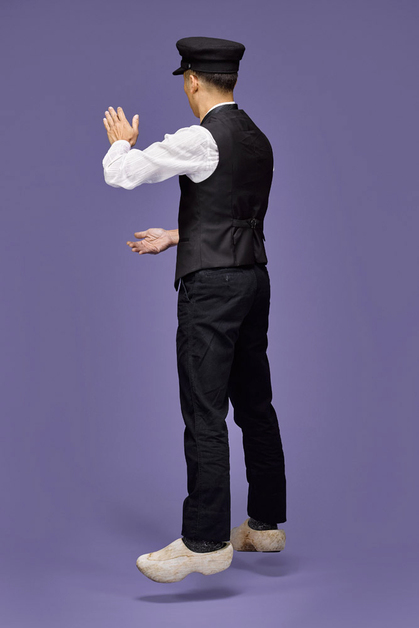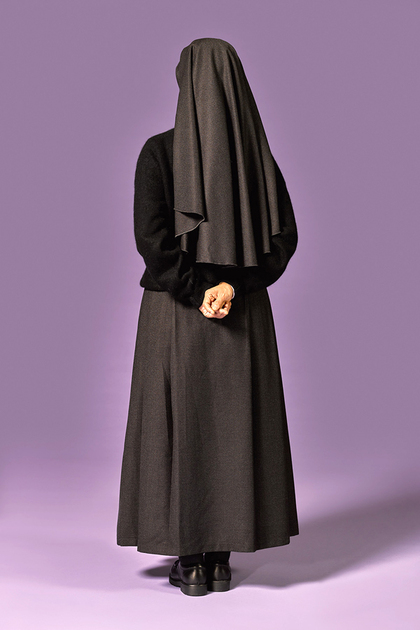-
From Current Issue
-
- Editor’s Letter Fire in the Heart
- Reviews I Gusti Ayu Kadek Murniasih
- Reviews 11th Seoul Mediacity Biennale: “One Escape at a Time”
- Dispatch Networked China
- One on One Monira Al Qadiri on Yukio Mishima
- Essays The rise of independent art spaces in pandemic-era Shanghai
- Features Tuan Andrew Nguyen
- Table of Contents
- Web Exclusives
- Archive
- Subscribe

R
E
V N
E
X
T
Installation view of LEUNG CHI WO and SARA WONG’s exhibition “Museum of the Lost” at Blindspot Gallery, Hong Kong, 2015. Courtesy Blindspot Gallery.
The collaborative photographic works of Hong Kong artists Leung Chi Wo and Sara Wong are presented in “Museum of the Lost,” the latest show at Blindspot Gallery, a spacious, full-floor gallery dedicated to contemporary photography, located in a former warehouse in the Wong Chuk Hang neighborhood. A set of 28 life-size photographs, from the two artists’ series “He was lost yesterday and we found him today” (2010–14), is being exhibited in its entirety for the first time, along with selections from “Museum of the Lost” (2013– ), their ongoing project of collecting archival materials, which are supplemented with descriptive captions written by Leung and Wong.
In the staged photographs, Leung and Wong portray unidentifiable figures that draw from the artists’ expanding archival collection—which dates back as far as 1935 and includes images taken from newspapers, magazines, brochures and other published sources. Interested in the anonymous people who, when caught on photographs, are peripheral to the main subject of the image, Leung and Wong select specific figures who exude a unique characteristic, or are in a particular action, as models for their work. Such reenactments allow the artists to resurrect the lost histories of these anonymous figures.
After picking out their protagonist from a photograph, the artists undergo a research process in an attempt to find out what the person was doing at the time his or her photograph was taken. However, their research often leads them beyond just the facts of the photograph’s history and inspires the artists to build a fictional narrative around the spotlighted characters.Leung and Wong’s approach of deconstructing and reconstructing archival images has also led them to pose as their chosen subjects, meticulously copying the attire and body language of the figures, while setting the scene against a simple, solid-color backdrop that is completely removed from its original context.
In Libyan Paramilitary Soldier With His Left Hand Pointing Up (2011), Leung, dresses in an army-green uniform, poses as a soldier attempting to draw attention to something happening to his left—though his signs appear to go unnoticed. The photograph itself seemingly captures an extracted moment devoid of context, prompting viewers to mentally piece together the rest of the story—like what the man could be alerting us to or whom he is addressing. If displayed alongside its original source image—showing a soldier perched atop an artillery tank, surrounded by protestors in Zawiyah, Libya (taken from an article published in South China Morning Post on March 1, 2011)—the much needed clues would allow one to gather a fuller understanding of the otherwise ambiguous figure in Leung and Wong’s work.
From the political to the cultural, Dancing Man Wearing Wooden Clogs (2014) portrays Leung posing as a Dutch dancer wearing wooden clogs with his back facing the audience. He appears to be in action as his feet are off the ground and hands captured in mid-motion. Displayed in a nearby vitrine, a short description accompanies the work’s original black-and-white photograph source, which is titled International Folk Dance Festival Open in Hyde Park, July 15, 1935. Weaving facts with the artists’ fictional narrative, the caption of Dancing Man goes on to detail the man wearing the clogs as somone who “learnt to dance from his parents and villagers,” adding that at age 40 he traveled “abroad for the first time.” Such personal descriptions are juxtaposed with the artists’ pared-down photographs and help bring their characters to life. Elsewhere, Nun With Hands Behind Her Back (2014) depicts Wong posing as a nun, with hands clasped behind her back, as if in deep contemplation. Elaborating on such ambiguities was the work’s source image, which depicts a nun in St. Peter’s Square in Rome as part of a Korean tourist promotion. In Leung and Wong’s work, the nun is pictured in the center, but with her back toward the viewers. This anonymity further adds to the intrigue—who is she, and where does she come from?
Coincidentally, the appropriation of found images in “He was lost yesterday and we found him today” is a fitting concept that mirrors the nature of the exhibition’s gallery space, which was made from repurposing an industrial warehouse. The exhibition “Museum of the Lost” poses many questions about how we deal with “official” history and perspective, archival materials, and how we perceive images and process information in our daily lives. While Leung and Wong’s fictional portraits pique one’s curiosity, it also gives agency to the imagination.
“Museum of the Lost” is on view at Blindspot Gallery, Hong Kong, until May 2, 2015.





